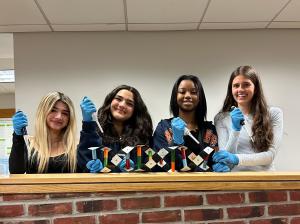

- Program:
- Barcode Long Island
- Year:
- 2024-25
- Research Topic:
- Wildlife
- Taxonomic Group Studied:
- Animals: Invertebrate
Project:
Biodiversity of Aquatic Macroinvertebrates in Shu Swamp and its Interconnected Ponds Versus the Isolated Bailey Arboretum Pond
- Students:
- Taylor Price, Sofia Schwarz, Isabella Panossian, Dylan Schefter
- School:
- Friends Academy, Nassau
- Mentors:
- Jennifer Newitt
Abstract:
High levels of nitrogen from septic systems, wastewater, and fertilizers contribute to hypoxia in the Long Island Sound (Save The Sound, 2022). This high nitrogen influx leads to eutrophication, where nutrient overload causes excessive phytoplankton and algal blooms. These blooms block sunlight from reaching submerged plants, reducing photosynthesis and oxygen production. When the algae die, bacteria break them down through aerobic decomposition, consuming significant dissolved oxygen. As oxygen levels drop, hypoxic conditions develop, stressing or killing oxygen-dependent aquatic species and reducing biodiversity (NOAA's National Ocean Service, 2024). Our study examines the biodiversity of aquatic macroinvertebrates in two water environments: Interconnected ponds (Beaver Brook and Mill River) that culminate at Shu Swamp and eventually flow into the Long Island Sound and a pond at Bailey's Arboretum that outflows only to one larger body of water, Mill Neck Creek, and is not nearly as i

